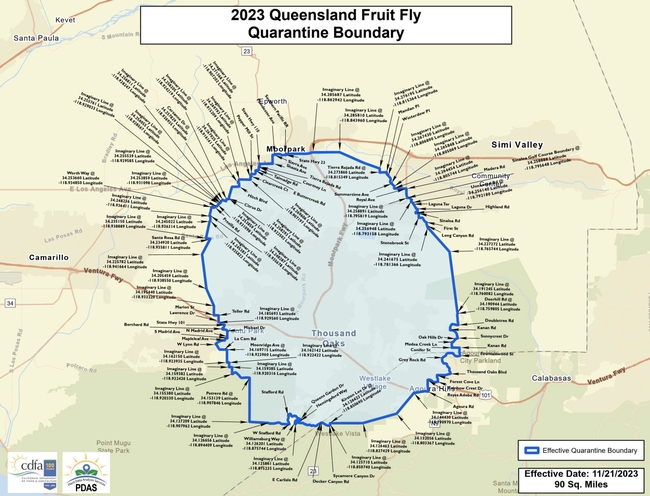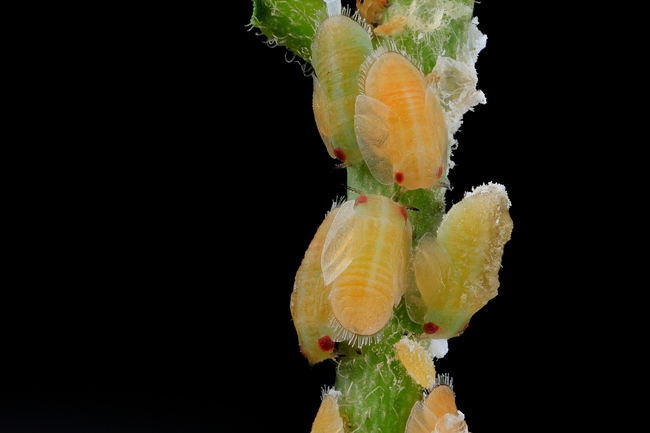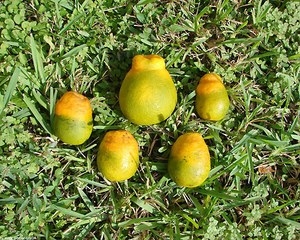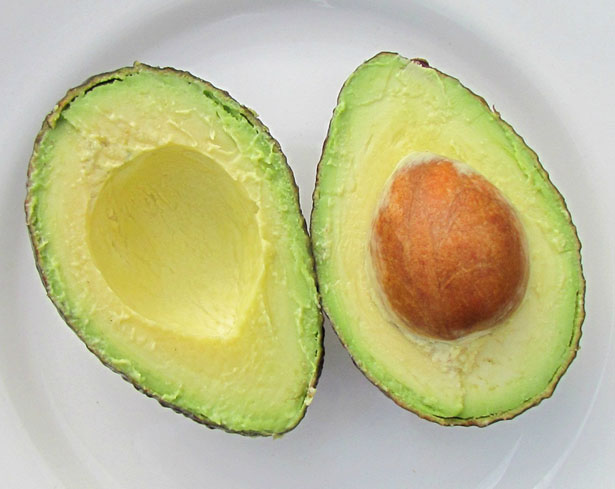- Author: Hamutahl Cohen
Queensland fruit fly quarantine?
Growers should consider the pre-quarantine program.
The Queensland fruit fly quarantine zone has been expanded (see: https://www.cdfa.ca.gov/plant/qff/regulation.html). Queensland fruit fly (also called QFF or Qfly) is a concern because it has over a hundred host plants and causes severe fruit damage. Like other tephritid fruit flies, it is challenging to control once the population takes hold.
What does this mean for growers in the quarantine zone? If a grower is in the zone (regardless of if they have Qfly on their ranch), their crop is on hold for one life cycle. Based on the weather, the life cycle length can vary. In the winter, life cycles are generally around 90 days. In the summer, the life cycle is about 30 days. Growers can view the length of the fruit fly life cycle here to determine how long the holding period is: https://www.cdfa.ca.gov/plant/pe/InteriorExclusion/pdf/QFF_Ventura_County-Thousand%20Oaks-2023-2024PreharvestTreatmentSchedule.pdf
During this holding period, growers must treat their crop repeatedly until the holding period expires. Growers must treat with Malathion + NuLure every 6-14 days for the duration of the holding period. This is a bait spray that must be mixed. To use Malathion, growers will need to notify the county ag commissioner and will need to register for special local need usage. For an additional option, growers can instead use GF-120 Spinosad bait every 7-10 days. GF-120 is premixed and therefore easier to use, but costs more than Malathion. When selecting which bait to use, growers should consider PHI for their crop and harvesting intervals. For example, GF-120 has a 4 hour PHI and Malathion has a 3 day PHI for strawberries – if a grower is harvesting every week, they may want to use GF-120. Growers need to spray bait around the perimeter of each field and throughout the field at spaced intervals.
Growers must comply with the treatment intervals, or they will have to start the holding period over.
After treatment, growers will receive a permit that is valid for 10 days and allows for movement of the crop.
If a grower is near the quarantine zone and anticipates economic losses due to a long holding period should they fall under quarantine, they can voluntarily opt to join a pre-quarantine program. The pre-quarantine program is overseen by the county. Treatments applied during the pre-quarantine period count towards the holding period if a grower falls under quarantine later on. This reduces the amount of time that the crop is on hold. This is a proactive measure that is optional. Please direct questions about the pre-quarantine program to the pest exclusion program at the Ventura County's Agricultural Commissioner's Office (806-388-4222 ext. 7165) or UC ANR at hcohen@ucanr.edu
Quarantine regulations apply to most crops within the quarantine zone, but 'Hass' avocado has been excluded from the host list for Queensland Fruit Fly and Oriental Fruit Fly and is not subject to quarantine regulations
More complete information regarding the mitigations required for citrus movement may be found on the Citrus Grower/Grove Manager Information page: https://phpps.cdfa.ca.gov/PE/InteriorExclusion/pdf/acpgrowerinformation.pdf

- Author: Ben Faber
The recent find of an infected adult Asian citrus psyllid in Santa Paula prompted the search for the potentially infected tree by CA Department of Food and Agriculture personnel to spread out to look and test. Two trees were found and presumably they will be destroyed. This now prompts a much more intense survey of the surrounding 2/10ths of a mile of those trees. It also places a quarantine on the movement of fruit out of that area, extending out 5 miles. That means no fruit or plant parts should be taken out of the area, potentially spreading the insects and disease to other areas, unless those plant parts have been properly treated. You can read more about the actions taken in a quarantine when infected insects or plants are found HERE . And in this document you can read about the details in and around a quarantined area and how the fruit and plants should be treated HERE.
As is the case in the spread of many invasive pests, it is humans that can be the main mode of movement of the pest and disease.

- Author: Ben Faber
|

- Author: Ben Faber
APHIS is proposing to amend its fruits and vegetables regulations to allow the importation of avocados from continental Spain into the United States. (This proposal does not include avocados from the Balearic Islands or the Canary Islands.)
As a condition of entry, avocados from Spain would have to be produced in accordance with a systems approach that would include requirements for importation in commercial consignments; registration and monitoring of places of production and packinghouses; grove sanitation; and inspection for quarantine pests by the national plant protection organization of Spain.
Consignments of avocados other than the Hass variety would also have to be treated for the Mediterranean fruit fly (Medfly) either prior to moving to the United States or upon arrival prior to release. Consignments would also be required to be accompanied by a phytosanitary certificate with an additional declaration stating that the avocados were grown and inspected and found to be free of pests in accordance with the proposed requirements.
This action would allow for the importation of avocados from Spain into the United States while continuing to provide protection against the introduction of quarantine pests.
We will consider all comments that we receive on or before April 1, 2013.
You may submit comments by either of the following methods:
- Federal eRulemaking Portal: Go to http://www.regulations.gov/#!documentDetail;D=APHIS-2012-0002-0001
- Postal Mail/Commercial Delivery: Send your comment to
Docket No. APHIS-2012-0002
Regulatory Analysis and Development
APHIS PPD Station 3A-03.8
4700 River Road Unit 118
Riverdale, MD 20737-1238
Supporting documents and any comments we receive on this docket may be viewed at http://www.regulations.gov/#!documentDetail;D=APHIS-2012-0002-0001 or in our reading room, which is located in room 1141 of the USDA South Building, 14th Street and Independence Avenue SW., Washington, DC. Normal reading room hours are 8 a.m. to 4:30 p.m., Monday through Friday, except holidays. To be sure someone is there to help you, please call (202) 799-7039 before coming.


- Author: Ben Faber
SACRAMENTO — An additional portion of Fresno County along its southern border with Tulare County has been placed under quarantine for the Asian citrus psyllid (ACP) following the detections of ACP in two locations in an unincorporated area of northern Tulare County near the City of Orange Cove. The quarantine expansion adds approximately 50 square miles to the existing quarantine for a total of 84 square miles in Fresno County. All of Tulare County remains under quarantine as a result of previous ACP detections.
The new quarantine area in Fresno County is bordered on the north by E Kings Canyon Road; on the south by the Fresno County Boundary Line; on the west by S Alta Avenue; and on the east by an unnamed creek. The quarantine map is available online at www.cdfa.ca.gov/plant/go/acp-qmaps.
The quarantine prohibits the movement of citrus and curry tree nursery stock out of the quarantine area and requires that all citrus fruit be free from ACP prior to moving out of the quarantine area. An exception may be made for nursery stock and budwood grown in USDA-approved structures which are designed to keep ACP and other insects out. Residents with backyard citrus trees in the quarantine area are asked not to transport citrus fruit or leaves, potted citrus trees, or curry leaves from the quarantine area.
ACP county-wide quarantines are now in place in Imperial, Los Angeles, Orange, Riverside, San Bernardino, San Diego, Santa Barbara, Tulare and Ventura counties, with portions of Fresno, Kern, Madera, San Joaquin, San Luis Obispo, and Santa Clara counties also under quarantine.
The ACP is an invasive species of grave concern because it can carry the disease huanglongbing (HLB), also known as citrus greening. All citrus and closely related species, such as curry trees, are susceptible hosts for both the insect and disease. There is no cure once a tree becomes infected; the diseased tree will decline in health and produce bitter, misshaped fruit until it dies. HLB has been detected just once in California – in 2012 on a single residential property in Hacienda Heights, Los Angeles County. This plant disease does not affect human health.
Residents in the area who think they may have seen ACP or symptoms of HLB on their citrus trees are urged to call CDFA's Invasive Species Hotline at 1-800-491-18991-800-491-1899 FREE. For more information on the ACP and HLB, please visit: www.cdfa.ca.gov/go/acp.
—California Department of Food and Agriculture




